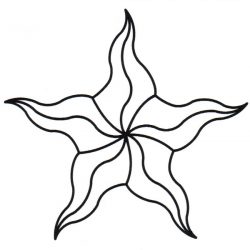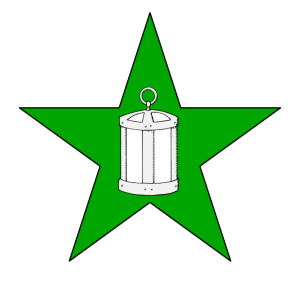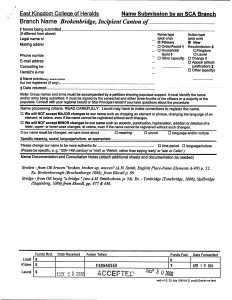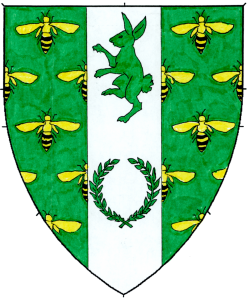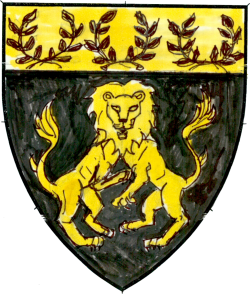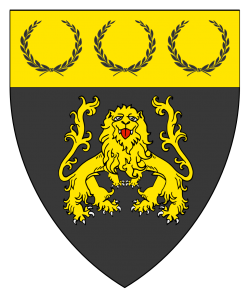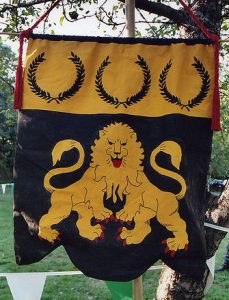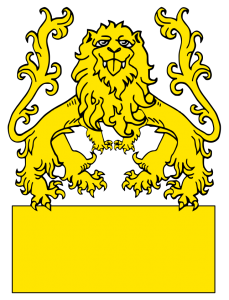As we approach the 50th anniversary of Østgarđr, and indeed of the East Kingdom — because in the beginning, Østgarđr was the East — we’ve been looking back over our history, and in keeping with that project I thought I would catalog the armorial devices of the viceroys and vicereines of Østgarđr since the earliest days. Continue reading “The Arms of The Viceroys and Vicereines of Østgarðr”
Category: Østgarðr
The Order of the Sea Dog
The Order of the Sea Dog of Østgarðr is an award for service to one of the cantons of Østgarđr. Its name is sometimes written as a single word, “Seadog.”
The name and badge are rich with allusion, as “sea dog” is both nautical slang for an experienced sailor and the heraldic term for a half-dog/half-fish creature with a broad scaly tail that is often identified with the beaver, a creature that was plentiful in the territory of Østgarđr during the medieval period, and is memorialized on the seal of New York City, adopted in 1686.
Continue reading “The Order of the Sea Dog”The Award of the Sea Star
The Award of the Sea Star is a token given to recognize service at an event in the Crown Province of Østgarđr.
According to The Annals of Østgarđr, it may be awarded by the Viceroy, Vicereine, or Provincial Seneschal.
It is described in the Provincial Bylaws as:
Continue reading “The Award of the Sea Star”The Honor of the Sea Star: Bestowed by the Viceregency upon individuals who have, on a particular occasion, served the Province well and ‘made things happen.’
Court Report, Whyt Whey Schola In The Solar
On October 28, A.S. LII, whilst his Excellency Suuder Saran, Il-Kha’an of Østgarđr, did lie abed recovering from a contagion, his fair lady Il-Khatun Lada Monguligin did venture forth unto her canton of Whyt Whey to attend a schola of arts and sciences, and there did share some of her talent in illumination with the populace, and did observe other displays of knowledge and partake in the feast that was set before her.
At the conclusion of the day, her Excellency held court, opening with kind words for the event and all who had attended.
Continue reading “Court Report, Whyt Whey Schola In The Solar”The Østgarðrian Ladies’ Favor
The Østgarðrian Ladies’ Favor is a former martial award of the Crown Province of Østgarđr. It has fallen out of use in recent decades.
The Bylaws describe it thusly:
Bestowed by the Vicereine (if any) upon the person who has most distinguished him/herself both on and off the list field. She may, if she chooses, confer with the other Ladies of Østgarðr. The Favor is worn for one year and may be rebestowed on the same person.
Mordred Mjothvitner reports that he received this award for two consecutive years during the 1990s, and that it was given during the Provincial Champions event by the vicereine and her attendants.
The Order of The Silver Sea-Lion
The Order Of The Silver Sea-Lion is the martial award of the Crown Province of Østgarđr.
It was created by His Excellency Gui Avec Chival (Viceroy AS XLVI–LI) to recognize both martial prowess and the leadership and training of others in the province in those skills.
The motto for the order is “I Go Forth, So That Others Might Follow”.
Continue reading “The Order of The Silver Sea-Lion”The Order Of The Silver Lantern
I’m continuing my earlier series of posts on the orders and awards of Østgarđr with some more detailed writeups of each one. More should follow soon. — Mathghamhain
The Order Of The Silver Lantern is an Arts & Sciences award of the Crown Province of Østgarđr.
The award was created by Her Excellency Johanne i Visby (Vicereine AS XLVI–LI) to “acknowledge skill, sharing and teaching in the Arts and Sciences.”
The heraldic registration for the order’s name and its badge were submitted in 2012, but the first design of the badge (which lacked the star) was returned for conflict and needed to be resubmitted before passing in 2013. (I’ve previously posted the submitted image and other details of these registrations.)
Continue reading “The Order Of The Silver Lantern”Orders and Awards of Østgarđr and the East Kingdom
Following a recent discussion of kingdom and provincial orders and awards, I thought I’d try my hand and putting together a visual overview, in part to force myself to wrap my head around all of them, and also in hopes that the result might be of use to others.
My point of reference for this was the East Kingdom Awards Overview created by Tola knitýr, which is itself based on a similar chart created for the Middle Kingdom by Gebhard.
Rather than just copying the existing chart, I wanted to make sure I understood the underlying awards, but after looking at various write-ups online, it turned out that many of them were out-of-date following a significant reorganization of the East Kingdom award structure that took effect in October 2015.
Continue reading “Orders and Awards of Østgarđr and the East Kingdom”Heraldic Registrations of the Canton of Brokenbridge
Brokenbridge is Østgarđr’s youngest canton, corresponding to Brooklyn, or King’s County.
Canton of Brokenbridge
The canton’s name was submitted in March 2006, and accepted in September.
The name is believed to reference one of the canton’s most iconic landmarks, the Brooklyn Bridge.
The documentation provides Old English sources for the two name elements:
Broken – from OE brocen “broken, broken up, uneven” (A.H. Smith, English Place-Name Elements A-IW) p. 52. Ex. Brokenborough (Brochenborge 1086), from Ekwall p. 68.
Bridge – from OE brycg “a bridge.” (see A.H. Smith above, p. 54). Ex. – Tonbridge (Tonebridge, 1086), Stalbridge (Staplebrig, 1086) from Ekwall, pp. 477 & 436.
(A similar branch name, the Bailiwick of Broken Bridges, was registered in August 1984 with the note that “Brokenbridge would be a more period form,” but was then released in December 1989 along with many other defunct branch names of the East.)
Vert semy of bees Or marked sable, on a pale argent in pale a coney rampant and a laurel wreath vert.
The canton’s arms were submitted in April 2006, and forwarded to the Society level in May, but then pended in September and not accepted until April of 2007. The pend was due to a confusion about the color of the bees’ wings: the submission form sent to Laurel blazoned them as “bees proper” but displayed bees with wings Or. (In the Society, bees proper have wings argent, body Or, with the abdomen marked with sable stripes.)
Curiously, the image that was uploaded to OSCAR didn’t match the version sent to Laurel — they both started from the same outline image, but the version on OSCAR had been colored differently, showing argent wings and four sable stripes rather than three. Because the image in OSCAR did depict bees proper, the issue was not flagged in commentary prior to reaching Laurel, at which point the September 2006 pend letter pointed out that the picture on the submission form they had received did not match the proposed blazon. The April 2007 LoAR modified the blazon to match the original submission image, “bees Or marked sable,” and accepted it for registration.
The arms are said to contain a rebus for another of the canton’s landmarks: the pale containing the coney can be read as “Coney Aisle,” or Coney Island. (I’ve also heard that the pairing of bees and rabbit provide a reference to “Bugs Bunny,” although I don’t know what connection that has to the canton.)
Heraldic Registrations of the Canton of Lions End
Lions End is Østgarđr’s easternmost branch, covering Nassau County.
Canton of Lions End
The canton’s name was submitted in July 1988, and accepted in October.
The note clarifies that the name does not contain an apostrophe:
Please note: Lions End is a place where lions go to meet. It is not what they sit upon when they sit down to eat. (I.e. it’s Lions plural not Lion’s possessive.) Lions was chosen during a naming binge to try to connect ourselves to our mundane geographic area, and is vaguely derived from Long Island (and various anagrams). The choice of the word End comes from our neighbors to the east An Dubhaigeainn (which translates to Abyss) and so we figured that before you get to the abyss you have to come to an end, and so “Lions End.”
Some additional commentary was added at the kingdom level to support this name, which received a mixed review in the LoAR when approving it for registration:
Although the analogue with Land’s End made on the letter of intent is not really accurate, the name is acceptable.
The distinction is routinely overlooked. For example, when the canton registered its arms in 1990 the acceptance was listed under the name “Lion’s End,” and only corrected sixteen years later. (Indeed as of this writing, the canton’s web site uses the apostrophe in the site’s title and home page, although elsewhere it uses the registered version.)
Azure, a bicorporate lion within a laurel wreath Or. (Returned)
The canton’s initial selection of arms featured a bi-corporate lion, an unusual charge featuring a lion’s head with two bodies attached to it.
It was returned in May 1989 with the note:
Conflict with the arms of John of Northampton, Mayor of London in 1381–83 (“Azure, a bicorporate lion guardant crowned Or.”). As Crescent has noted, this is a frequently depicted piece of armoury. Indeed, it is almost the “defining instance” for the bicorporate lion in most handbooks.
Although the rules have changed since, at the time the Society’s rules for armory conflict included checking against the arms issued by other jurisdictions, including medieval England.
Sable, a bicorporate lion and on a chief Or, three laurel wreaths sable.
A revised version of the device was submitted a few months later, and approved in May of 1990 without comment.
The lion is an allusion to the mundane county of Nassau, which has as its arms “azure, a lion rampant between seven billets Or,” which is derived from the arms of the European house of Nassau, “azure billetty, a lion rampant Or armed and langued gules.”
An attractive depiction of the arms is provided by canton’s heraldic banner.
Sable, a bicorporate lion and on a chief Or, three laurel wreaths vert. (Error)
Due to a scribal transcription error around that time, the arms listed in the Society’s armorial database differ from the registration in the tincture of the laurel wreaths, which were listed as vert instead of sable. [Edited May 23: the correction was rolled out in today’s database update and it is now listed correctly as three laurel wreaths sable.]
As a result, a number of illustrations of the branch’s arms which were taken from that blazon have been drawn incorrectly, including the version that’s currently shown on the canton’s home page, as well as the East Kingdom wiki and other places.
Following the discovery of this error, the O&A is currently being adjusted to match the original registration.
[Edited June 17: Local oral history holds that the wreaths were changed to green because of a ruling at the time that all laurel wreaths must be vert. However, the lack of commentary in the LoAR which accepted the arms with sable wreaths, and the contemporaneous registration of numerous wreaths of other tinctures, suggests that this is post-facto mythologizing — this really was due to a simple scribal error during data entry.]
A bicorporate lion atop a billet fesswise Or.
The canton submitted a populace badge in mid-2013, which was registered that November.
It features the same bicorporate lion as in the branch arms, standing on a billet (the heraldic term for a rectangle).
According to Yehuda ben Moshe, canton herald at the time, the initial intention was to register just a fieldless bicorporate lion Or, which members of the populace had already begun using as an informal populace badge. However, this was found to be too similar to another registration, the holder of which declined to grant permission to conflict, and so they looked for something simple that could be added to existing badges and settled on a billet, which is another design element present in the aforementioned arms of Nassau County.
For the curious, the territory of Lions End was previously home to the Canton of Mandan, sometimes spelled Madnan, which was formed in October 1980, had its name registered in January 1983, went defunct in May 1985, and had its name released in a December 1989 purge of defunct East Kingdom branches, according to Lord Richard the Poor’s “A Geographic History of the East Kingdom” and the Society’s armorial records. The name may have been an allusion to “Madnan’s Neck,” a seventeenth-century name for the Great Neck region, derived from “Menhaden-Ock,” its native Mattinecock name, itself a reference to the small Menhaden fish then plentiful in the region.


